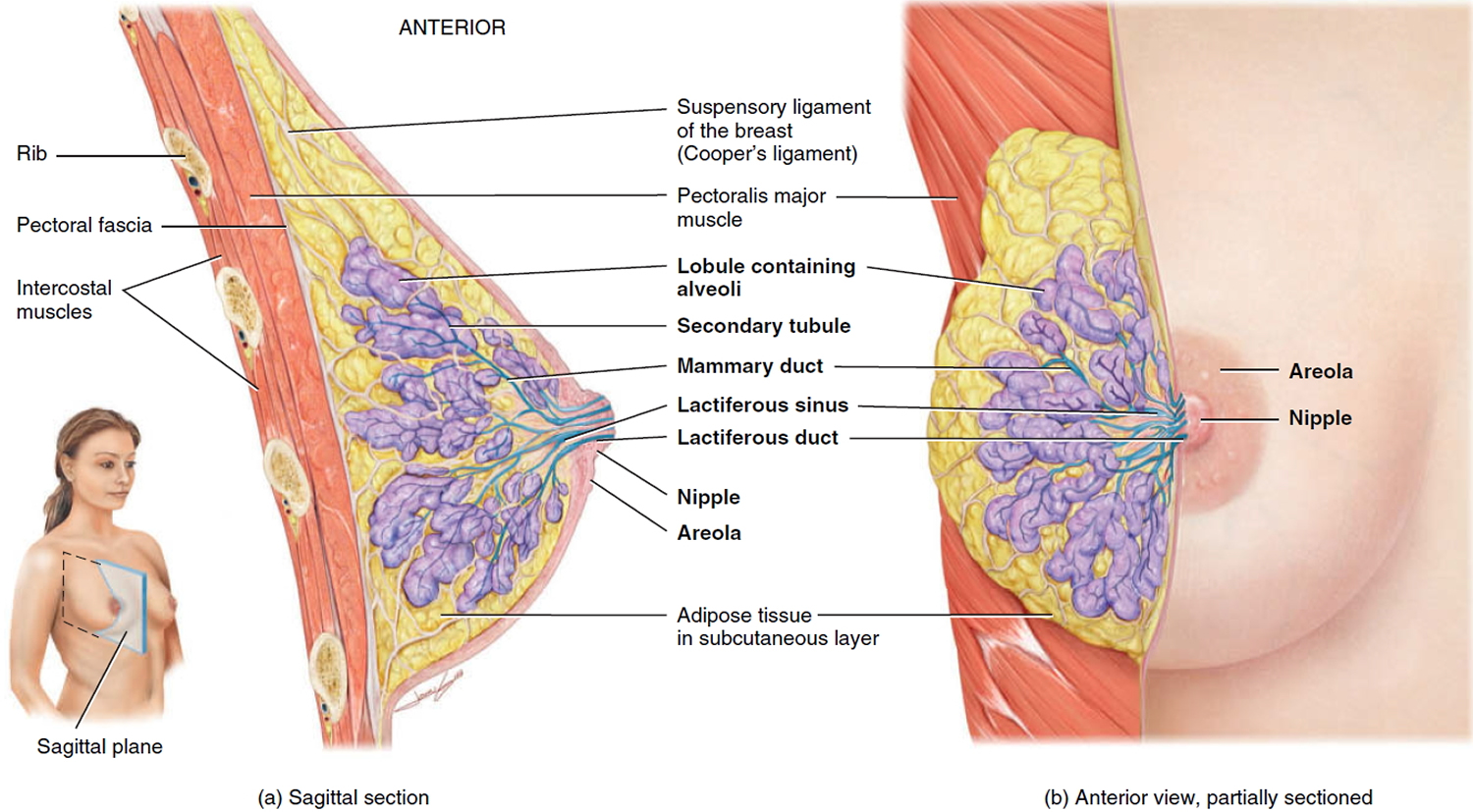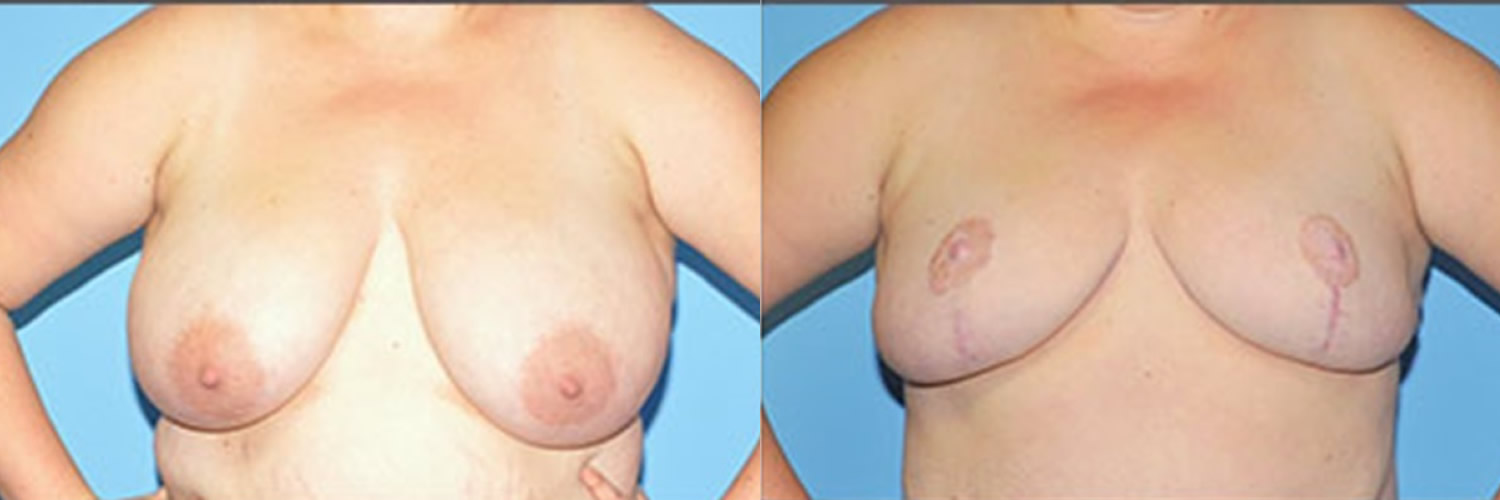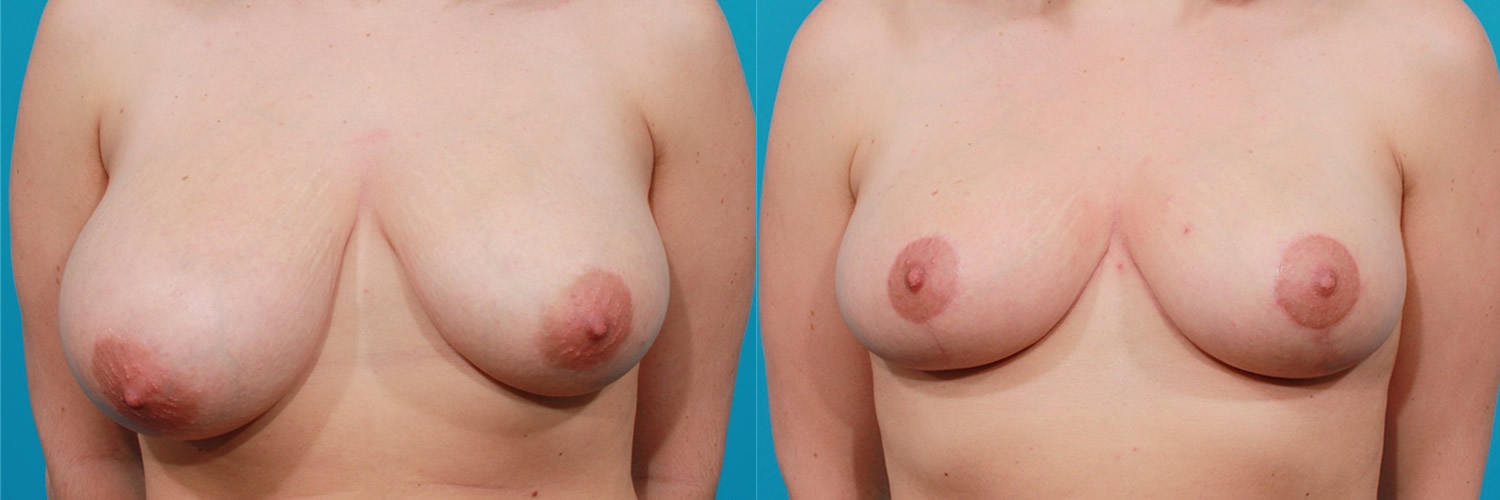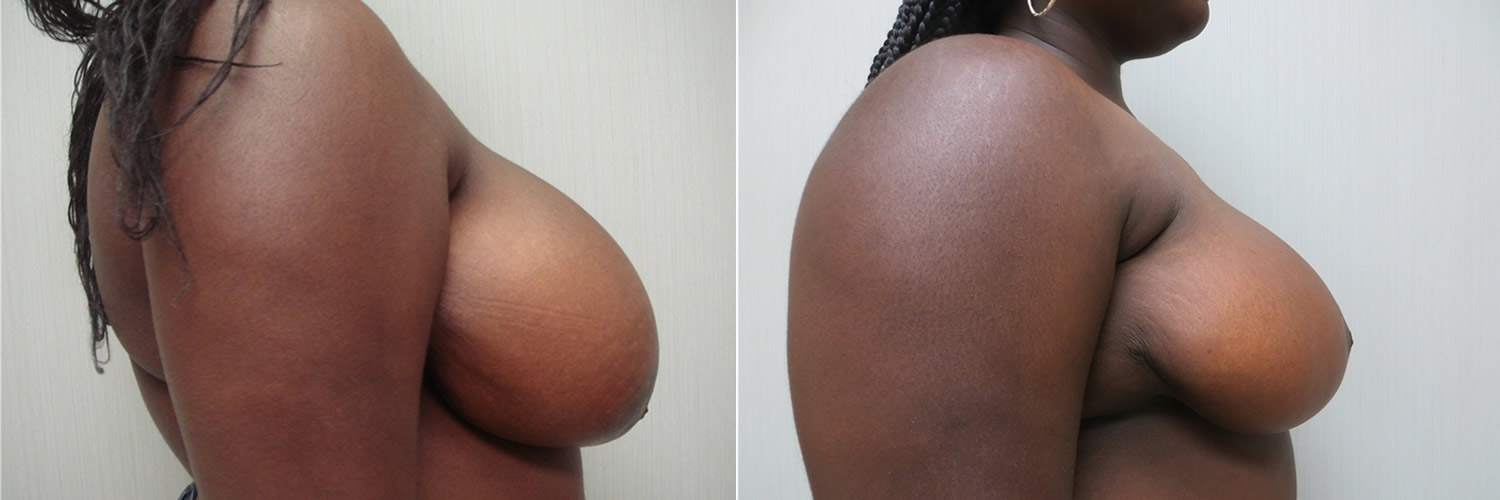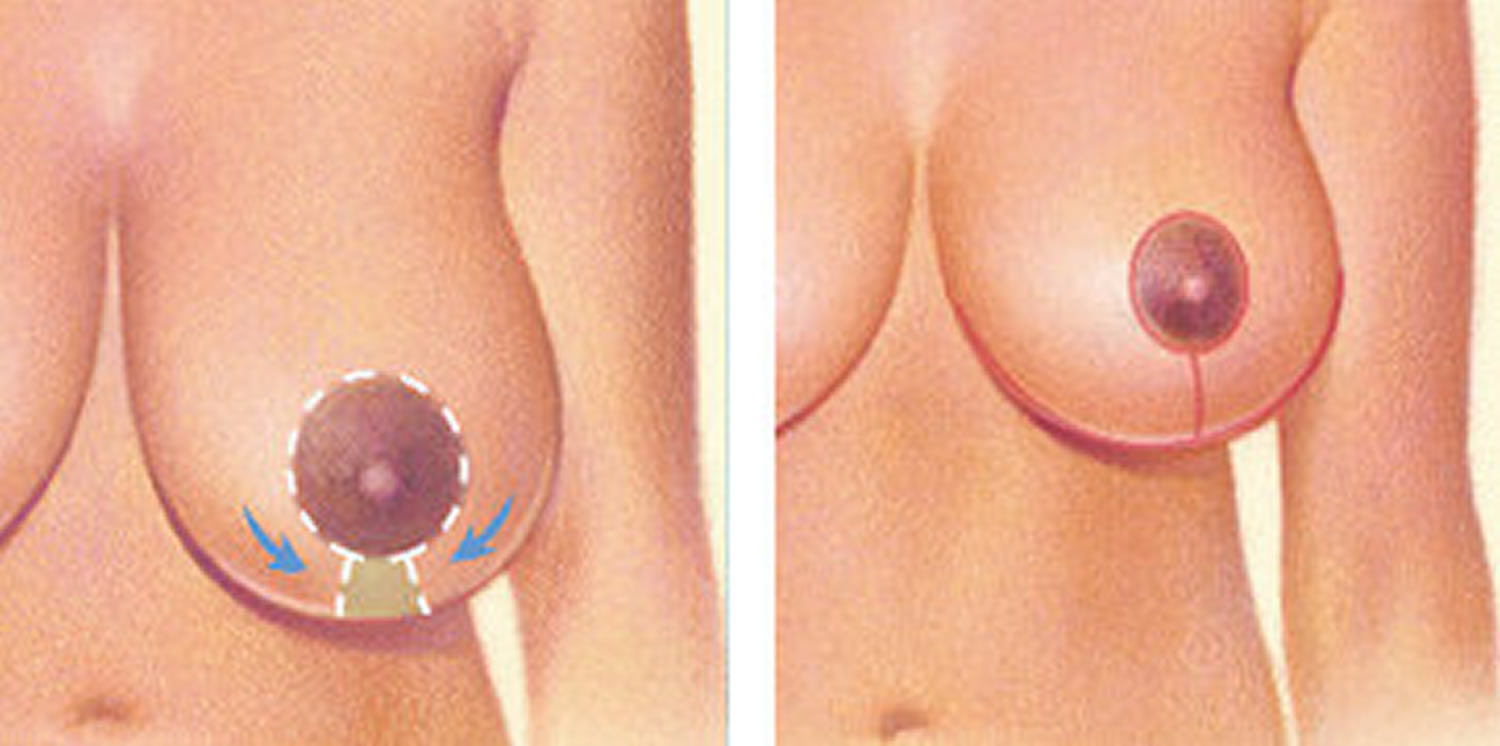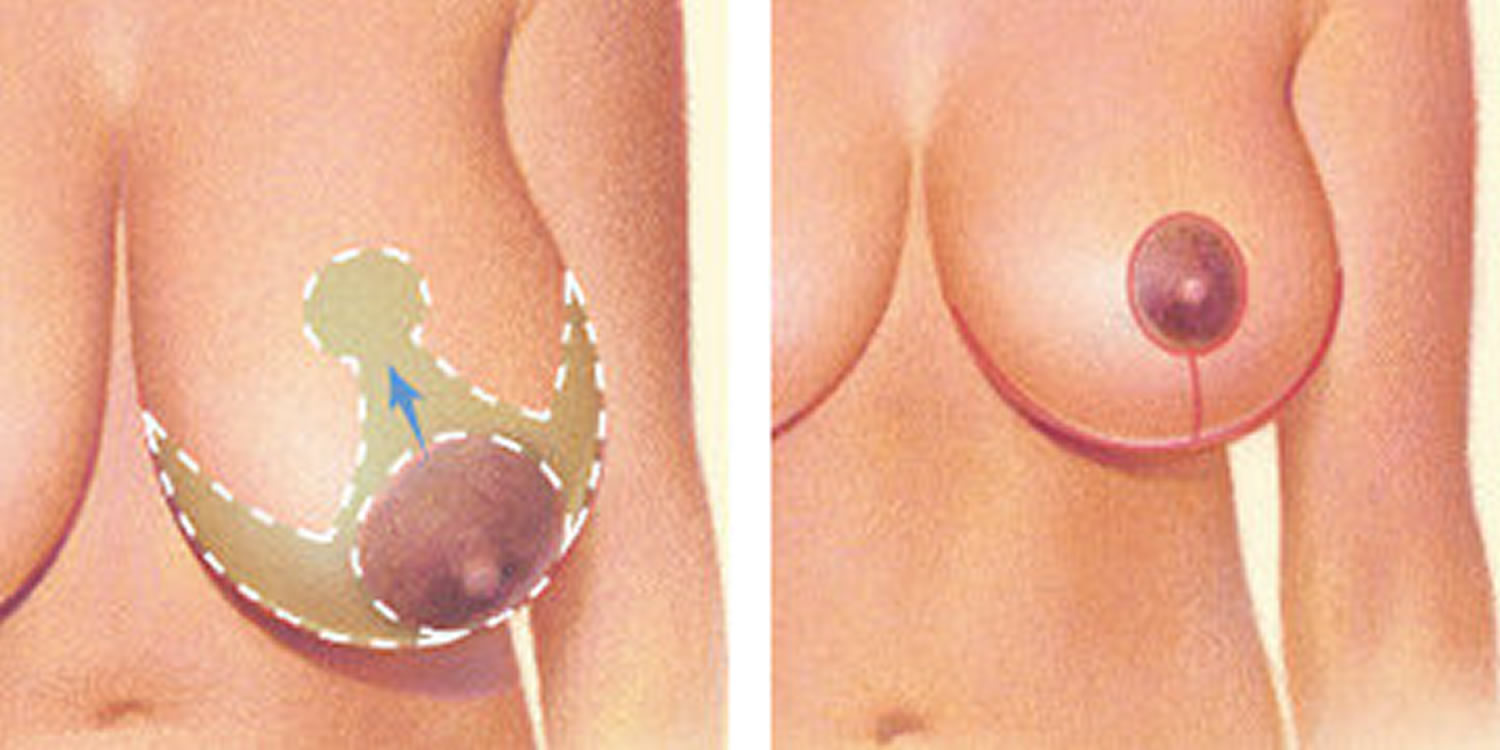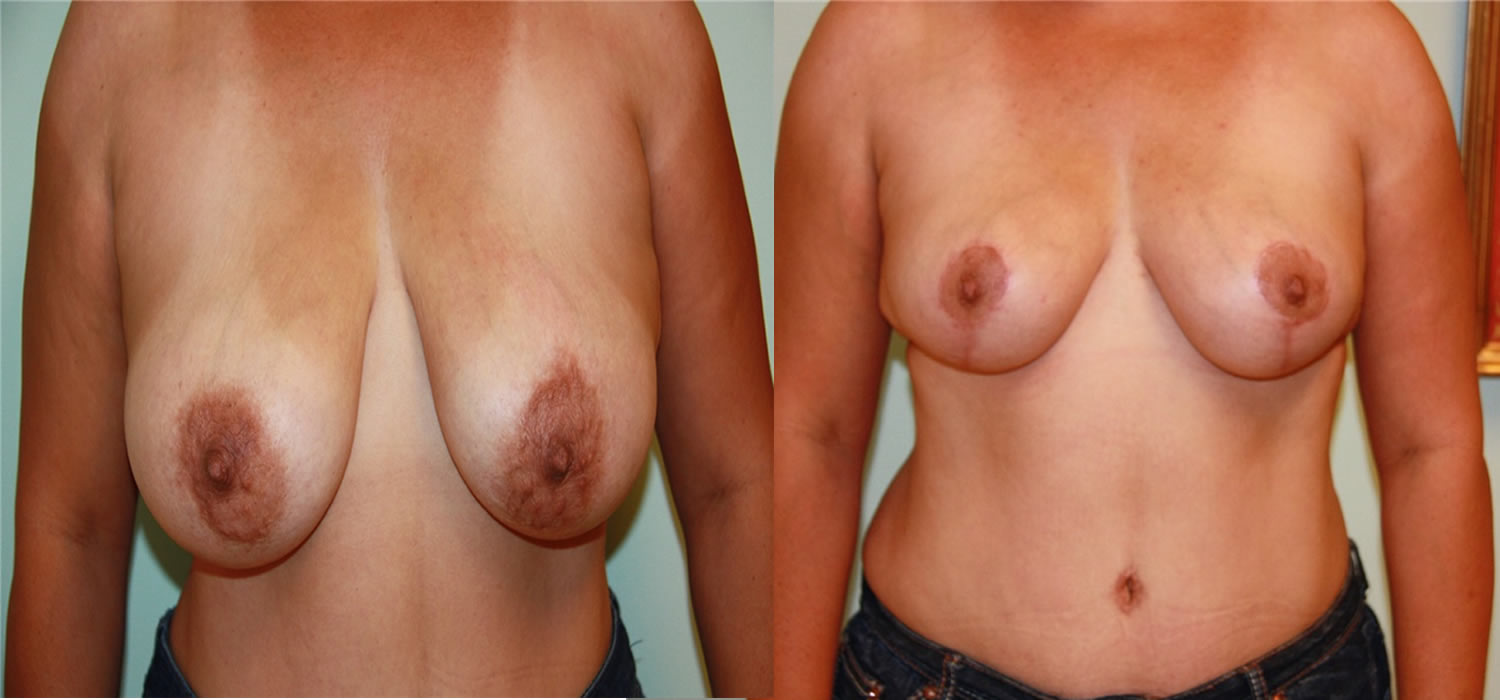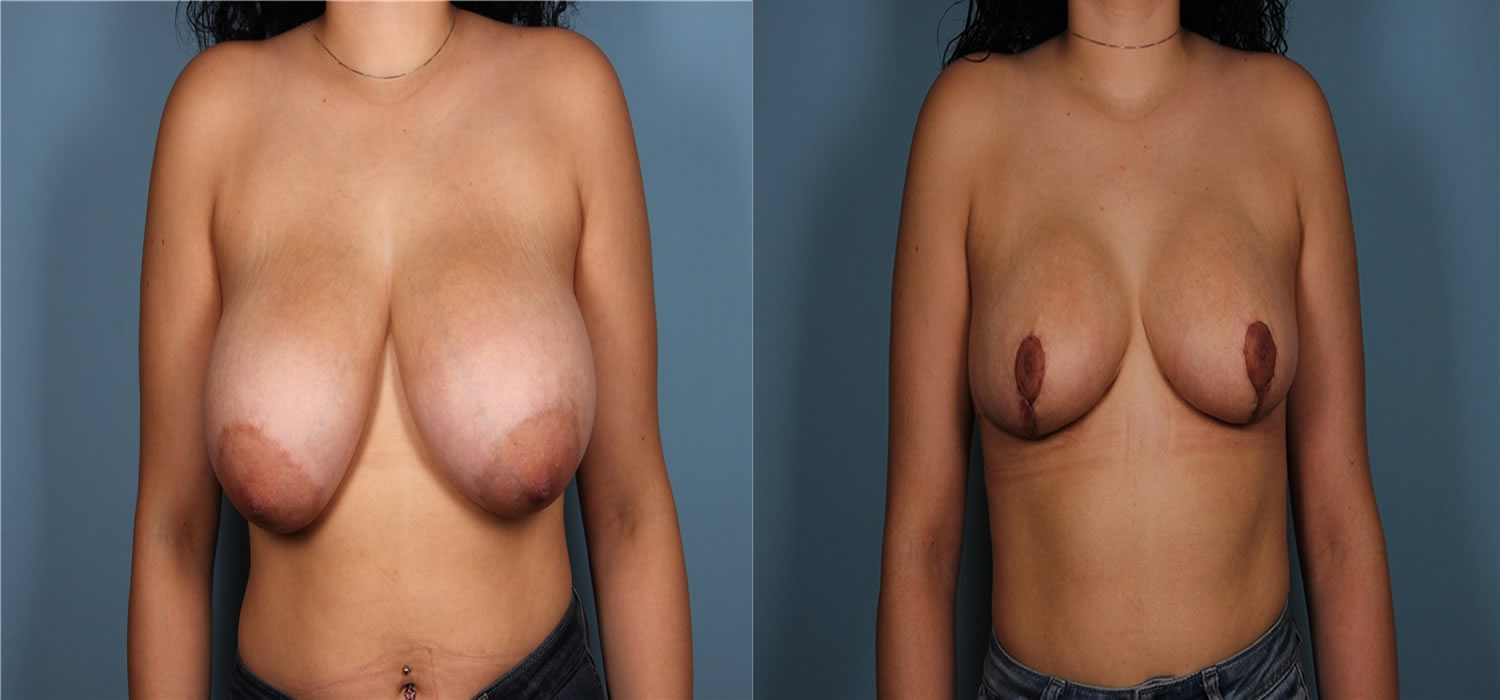Contents
- What is breast reduction
- Is breast reduction surgery right for me?
- Breast reduction surgery risks and potential complications
- Breast reduction how you prepare
- Breast reduction procedure
- What to expect after breast reduction surgery
- Breast reduction results
- Breast reduction with lift
- Male breast reduction
What is breast reduction
Breast reduction, also known as reduction mammoplasty or reduction mammaplasty, is a surgical procedure that reduces the size of overly large breasts. Overly large breasts can cause health issues and emotional problems for some women. In addition to self image issues, it can also cause physical pain and discomfort. In the United States, over 500,000 women undergo breast surgery procedures each year 1).
Breast reduction surgery removes excess breast fat, glandular tissue and skin to achieve a breast size in proportion with your body. The procedure is designed to alleviate the discomfort associated with overly large breasts. Breast reduction surgery might also help improve your self-image and your ability to participate in physical activities.
If you’re considering breast reduction surgery, consult a board-certified plastic surgeon. It’s important to understand what breast reduction surgery entails — including possible risks and complications — as well as set realistic expectations.
Breast reduction surgery is usually done under general anesthesia, either in a hospital or outpatient surgical facility.
Breast reduction surgery is meant for women who have large breasts and want to resolve issues such as:
- Chronic back, neck and shoulder pain that requires pain medications
- Chronic rash or skin irritation under the breasts
- Nerve pain
- Restricted activity
- Poor self-image related to large breasts
- Difficulty fitting into bras and clothing
Breast reduction surgery generally isn’t recommended if you:
- Smoke
- Have certain conditions such as diabetes or heart problems
- Are very obese
- Want to avoid scars on your breasts
You can have breast reduction surgery at any age — sometimes even as a teenager. But if your breasts aren’t yet fully developed, you might need a second surgery later in life.
You might postpone breast reduction surgery if you have certain future plans, such as:
- Childbirth. If you haven’t started a family or your family isn’t yet complete, you might wait until pregnancy isn’t an issue. Breast-feeding might be challenging after breast reduction surgery — although certain surgical techniques can help preserve your ability to breast-feed.
- Weight loss. If you are interested in losing weight by changing your diet and starting an exercise program, you might wait to decide if breast reduction is for you. Losing weight can often result in changes to your breast size.
Is breast reduction surgery right for me?
Breast reduction is a highly individualized procedure and may not be suitable for everyone. Always talk to your board-certified plastic surgeon before making a decision. Your board-certified plastic surgeon will assess your condition and general health, and plan the treatment that is best suited to you.
Before you decide on breast reduction surgery, there are some important issues to keep in mind:
- Surgeons generally recommend waiting until breast development, child birth and breastfeeding have stopped before undertaking breast reduction surgery
- Breast reduction surgery can interfere with some diagnostic procedures
- Ability to breastfeed following breast reduction surgery may be affected. Talk to your surgeon if you are planning to breastfeed a baby in the future
- Changes in the breasts during pregnancy, or significant weight loss or gain can alter the outcomes of previous breast reduction surgery
- Breast and nipple piercings can cause an infection
- Smokers are at increased risk of complications. If you are serious about undergoing surgery, you should quit smoking
Breast reduction may be a good option for you if:
- You are physically healthy
- You have realistic expectations
- Your breasts are fully developed
- You are bothered by the feeling that your breasts are too large
- Your breasts limit your physical activity
- You experience back, neck and shoulder pain caused by the weight of your breasts
- You have regular indentations from bra straps that support heavy, pendulous breasts
- You have skin irritation beneath the breast crease
- Your breasts hang low and have stretched skin
- Your nipples rest below the breast crease when your breasts are unsupported
- You have enlarged areolas (pigmented skin surrounding the nipple) caused by stretched skin
Remember that the shape and size of your breasts before surgery will influence the breast reduction surgical procedure and the outcome.
Figure 1. Normal breast (female)
Figure 2. Breast reduction surgery
Note: The typical anchor-shaped incision in breast reduction surgery allows the surgeon to remove excess breast tissue, fat and skin and raise the nipple and areola, as shown on top. After the excess tissue is removed, the surgeon brings the skin underneath the breast together with stitches, as shown at bottom.
Figure 3. Breast reduction before and after
Will I need anaesthesia?
Yes, breast reduction surgery is nearly always done under general anaesthesia. Modern anaesthesia is safe and effective, but does have some risks. Ask your Specialist Plastic Surgeon and anaesthetist for more information. Your surgeon and/or anaesthetist will ask you about all the medications you are taking or have taken, and any allergies you may have. Make sure you have an up to date list before the surgery.
Will I have scarring after my breast reduction surgery?
Scars are an inevitable part of any invasive surgery. Your incision scars might fade over time but will never completely disappear. Your specialist plastic surgeon will endeavour to minimize scarring and to keep your scars as inconspicuous as possible by locating the incisions in easily hidden sites. That way, scars will be along natural skin lines and creases. Scars may fade with time and become barely noticeable. If you are prone to scarring, you should advise your surgeon.
Will I need revisional surgery?
In most circumstances, breast reduction surgery does not need to be repeated. However, as with all surgical procedures, revisional surgery may be necessary to correct minor irregularities.
Where will the breast reduction surgery take place?
Depending upon your general health and the extent of the procedure, breast reduction surgery can be performed either as a day case or alternatively with a short hospital stay. Your Specialist Plastic Surgeon will advise on the best option for you.
What are the costs associated with breast reduction surgery?
Cost is always a consideration in elective surgery. Prices for individual procedures can vary widely between plastic surgeons. Some factors that may influence the cost include the surgeon’s experience, the type of procedure used and the geographic location of the office.
Costs associated with the breast reduction procedure may include:
- Surgeon’s fee
- Hospital or surgical facility costs
- Anaesthesia fees
- Prescriptions for medication
- Post-surgery garments
- Medical tests
Breast reduction surgery is generally considered a reconstructive procedure and may be covered by health insurance when it is performed to relieve medical symptoms. Many insurers define breast reduction surgery as reconstructive based on the amount of tissue that will be removed. However, pre-certification is required for reimbursement or coverage. Insurance policies may vary greatly. Review your policy carefully to determine what is covered.
Breast reduction surgery risks and potential complications
Modern surgery is generally safe but does have the potential for risks and complications to occur.
Breast reduction surgery has the same risks as any other type of major surgery — bleeding, infection and an adverse reaction to the anesthesia.
Some possible complications and risks associated with breast reduction surgery may include:
- Risks of anaesthesia including allergic reaction or potentially fatal cardiovascular complications such as heart attack
- Surgical risks such as bleeding or infection
- Breathing difficulties due to general anaesthetic or the endotracheal tube which can cause swelling, noisy breathing and discomfort
- A blood clot in the deep veins of the legs (deep vein thrombosis), which can move to the lungs (pulmonary embolus) or to the brain and may be life threatening
- Fluid accumulation around the operation site(s)
- Allergic reaction to suture materials, tape adhesive or other medical materials and lotions
- Skin discoloration, permanent pigmentation changes, swelling and bruising
- Damage to deeper structures – such as nerves, blood vessels, muscles, and lungs – can occur and may be temporary or permanent
- Fatty tissue deep in the skin could die (fat necrosis)
- Changes in breast and nipple sensation
- Temporary or permanent areas of numbness
- Asymmetry (unevenness) of the breasts
- Potential partial or total loss of nipple and areola
- Need for further surgery to treat complications
- Bruising, which is usually temporary
- Scarring
- Removal of or loss of sensation in the nipples and skin surrounding the nipples (areolae)
- Difficulty or inability to breast-feed
- Differences in the size, shape and symmetry of the surgically altered left and right breasts, which might lead to further surgery to improve your appearance
Breast reduction how you prepare
You will also be asked to provide a complete medical history for your specialist plastic surgeon including any health problems you have had, any medication you are taking or have taken, and any allergies you may have.
You may be advised to stop taking certain medicines such as non-steroidal anti-inflammatory drugs (NSAIDs), aspirin, and medicines that contain aspirin. You may also be asked to stop taking naturopathic substances such as garlic, ginko, ginseng and St John’s Wort as they may affect clotting and anaesthesia. Always tell your surgeon EVERYTHING you are taking.
You may be given medicines to take before the surgery, such as antibiotics.
Your plastic surgeon will likely:
- Evaluate your medical history and overall health
- Discuss your expectations for breast size and appearance after the surgery
- Provide a detailed description of the procedure and its risks and benefits, including likely scarring and possible loss of sensation
- Examine and measure your breasts
- Take photographs of your breasts for your medical record
- Explain the type of anesthesia used during surgery
A physical examination is necessary to choose the right technique. The following are noted:
- Size of the breast; density of its parenchyma; ptosis
- Estimated amount of the breast tissue to be retained (this is more important than the amount to be resected)
- Body mass index (BMI) (patients with BMI >35 must be encouraged to lose weight)
- Photography (from the front and sides).
Before breast reduction surgery, you might also be asked to:
- Complete various lab tests
- Get a baseline mammogram
- Stop smoking for a certain period of time before and after surgery
- Avoid taking aspirin, anti-inflammatory drugs and herbal supplements, to control bleeding during surgery
Ask your surgeon whether you’ll be able to go home the day of the surgery or whether you’ll need to spend a night in the hospital. Arrange for someone to drive you home after surgery or when you leave the hospital.
Questions your surgeon may ask before the breast reduction surgery include:
- Do you have an allergy or bad reaction to antibiotics, anaesthetic drugs or any other medicine?
- Do you have prolonged bleeding or excessive bruising when injured?
- Do you have a connective-tissue disorder such as rheumatoid arthritis, scleroderma, lupus erythematosis, or any other arthritis-like disorder?
- Do you have any long-term or recent illnesses?
- Have you previously had surgery for breast cancer, or radiotherapy to the breast?
- Have you had psychological or psychiatric illnesses?
Unless your surgeon advises differently, you will be able to continue taking most medicines that you have been taking.
Your surgeon will advise you if any other tests are required, such as blood tests, X-ray examinations or an electrocardiograph (ECG or EKG) to assess your heart.
Prepare a “recovery area” in your home. This may include pillows, ice packs, a thermometer and a telephone within easy reach. Make sure you arrange for a relative or friend to drive you to and from the hospital or clinic. Someone should also stay with you for at least 24 hours after you return home.
Your surgeon should give detailed preoperative instructions. Follow them carefully.
Breast reduction procedure
The specific technique used to reduce the size of your breasts can vary. The procedure might include:
- Surgery through incisions
- Liposuction to remove the excess fat in your breasts
Whatever technique is chosen, the following steps have to be adhered to:
- Marking of the patient in standing position
- Midsternal line from suprasternal notch to the xiphisternum
- Breast meridian: 7.5 cm from the suprasternal notch on the clavicle, a perpendicular line is drawn onto the breast mound, which usually passes through the nipple
- The distance from the suprasternal notch to the nipple is measured
- The inframammary crease is marked. The distance from the nipple to the crease is noted. The new nipple position is marked on the breast meridian 2) varying from 18 to 24 cm depending on the height of the individual. Err on marking the new nipple position too low, rather than too high 3)
- The new location of the areola is marked with an areola diameter of 45 to 55 mm
- Skin incision lines are marked depending on the technique chosen.
- An informed consent is taken.
The surgeon usually:
- Makes an incision around the areola and down each breast
- Removes excess breast tissue, fat and skin to reduce the size of each breast
- Reshapes the breast and repositions the nipple and areola
The nipple and areola:
- Usually remain attached to the breast
- Might need to be removed and then reattached at a higher position as a skin graft if your breasts are very large
Your surgeon will try to achieve symmetry between your breasts, but some variation in breast size and shape might occur. The size of the areola also might be reduced. Your incision scars might fade over time but will never completely disappear.
Breast reduction incision options include:
Circum areolar breast reduction
This procedure 4) can be chosen for mild hypertrophy of a tubular breast with enlarged areola (small volume reduction with mastopexy) 5). The incision is made around the areolar perimeter and the required size of areola is preserved. The rest of the areola is excised like a de-epithelised skin flap. The incision is deepened in the lower half of the areola and the required amount of breast tissue is excised. The wound is closed in three layers. The deeper suture is with a non-absorbable suture. The second suture layer is to reduce the gap further and skin is closed with interrupted sutures. This technique aims to avoid a visible stitch line. This procedure can be preceded by liposuction, which helps in reducing the volume [Figure 4].
The unfavourable results of circum areolar breast reduction procedure are:
- Inadequate reduction of breast as there is limitation in exposure
- Removal of excess skin via a periareolar route may result in a flat appearance 6)
- The scar around the areola may become prominent, hypertrophic and may take a long time to settle.
Figure 4. Breast reduction option – circular pattern around the areola – The incision lines that remain are visible and permanent scars, although usually well concealed beneath a swimsuit or bra.
Figure 5. Breast reduction option – a keyhole or racquet-shaped pattern with an incision around the areola and vertically down to the breast crease
Figure 6. Breast reduction option – an inverted T or anchor-shaped incision pattern
Removing tissue and repositioning
After the incision is made, the nipple (which remains tethered to its original blood and nerve supply) is then repositioned. The areola is reduced by excising skin at the perimeter, if necessary.
Underlying breast tissue is reduced, lifted and shaped. Occasionally, for extremely large pendulous breasts, the nipple and areola may need to be removed and transplanted to a higher position on the breast (free nipple graft).
Closing the incisions
The incisions are brought together to reshape the now smaller breast. Sutures are layered deep within the breast tissue to create and support the newly shaped breasts; sutures, skin adhesives and/or surgical tape close the skin. Incision lines are permanent, but in most cases will fade and significantly improve over time.
What is liposuction breast reduction?
Liposuction is a surgical procedure that uses a suction technique to remove fat from specific areas of the body, such as the breasts as part of the breast reduction procedure, abdomen, hips, thighs, buttocks, arms or neck. Liposuction also shapes (contours) these areas. Other names for liposuction include lipoplasty and body contouring.
Liposuction alone as a breast reduction procedure
This is very effective and useful in unmarried girls leaving no visible scar and no other morbidity such as haematoma, seroma and nipple necrosis. The ideal patient for such a procedure 7) is a young patient with juvenile fatty breast parenchyma with good skin elasticity and tone. For better assessment, a preoperative mammography may be of great help.
Moskovitz et al. 8) conducted a survey to know the outcome of the liposuction for breast reduction. The survey revealed that 80% were satisfied with the result and would go on to recommend it to a friend. Thus, it can be considered as an effective method of breast reduction.
Liposuction isn’t recommended for people who have conditions that could complicate surgery, including:
- Restricted blood flow
- Coronary artery disease
- Diabetes
- A weak immune system
After breast reduction procedure
Immediately after breast reduction surgery:
- Your breasts will be covered with a gauze dressing or bandages
- A tube might be placed under each arm to drain any excess blood or fluid
- You likely will take medication for pain and antibiotics, to decrease your risk of infection
For the first days or week after breast reduction surgery:
- Your breasts will probably feel tender and sensitive
- Your breasts might be swollen and bruised
- Your surgeon might recommend an elastic compression bra to protect the breasts
After that:
- You’ll need to limit physical activity for two to four weeks while the breasts heal
- Your surgeon might suggest avoiding underwire bras for a few months after surgery
Scarring usually fades over time. You will need a follow-up visit with your surgeon to remove stitches and check your recovery.
What to expect after breast reduction surgery
While you are healing, you may experience some pain, bruising, swelling and numbness around the operated site. This is normal. Your specialist plastic surgeon will prescribe pain relief as needed. If you have any problems or concerns, be sure to tell your surgeon.
After surgery, you will wear an elastic dressing or surgical bra to provide support for your breast. A plastic tube may be inserted into each breast to drain excess fluid. Other dressings may be changed or removed at this time.
Depending on the extent of your procedure, you may need to take a few days off work to rest. Avoid heavy lifting, strenuous exercise, swimming and strenuous sports until advised by your surgeon.
If you experience any of the following symptoms, notify your surgeon immediately:
- Temperature higher than 38ºC (100 °F) or chills
- Nausea, vomiting, shortness of breath or diarrhea
- Heavy bleeding from the incisions
- Leakage of blood or fluid beyond the first day after surgery
- Worsening and/or spreading redness around the incision sites
- Increasing pain or tenderness in either breast
- Any other concerns or problems regarding your surgery, particularly if it appears to be worsening
Breast reduction recovery
Your surgeon will give you specific instructions on post-operative care. These instructions may include:
- How to care for your surgical site(s) following surgery
- Medications to apply or take orally to aid healing and reduce the risk of infection
- Specific concerns to look for at the surgical site(s) or regarding your general health
- When to follow-up with your surgeon
Be sure to ask your surgeon specific questions about what you can expect during your individual recovery period, such as:
- Where will I be taken after my surgery is complete?
- What medication will I be given or prescribed after surgery?
- Will I have dressings/bandages after surgery? If so, when will they be removed?
- Are stitches removed? When have they/will they be removed?
- When can I resume normal activity and exercise?
- When do I return for follow-up care?
Breast reduction results
Successful breast reduction surgery can relieve pain in your upper back, neck and shoulders. It might also increase your ability to participate in physical activities and promote a more positive self-image.
Although you’ll see results immediately, remember that it can take months for the swelling to completely go down and the surgical scars to fade. The final result is generally permanent — although breast shape and size can change due to factors such as aging and weight gain or loss.
Breast reduction with lift
A breast lift — also known as mastopexy — is a surgical procedure to change the shape of your breasts. During a breast lift, excess skin is removed and breast tissue is reshaped to restore firmness and raise the breasts.
You might choose to have a breast lift if your breasts sag or your nipples point downward. A breast lift might also boost your self-image and self-confidence.
A breast lift won’t significantly change the size of your breasts. However, a breast lift can be done in combination with breast augmentation or breast reduction.
Why is breast lift done?
As you get older, your breasts change — losing elasticity and firmness. There are many causes for these kinds of breast changes, including:
- Pregnancy. During pregnancy, the ligaments that support your breasts might stretch as your breasts get fuller and heavier. This stretching might contribute to sagging breasts after pregnancy — whether or not you breast-feed your baby.
- Weight fluctuations. Changes in your weight can cause your breast skin to stretch and lose elasticity.
- Gravity. Over time, gravity causes ligaments in the breasts to stretch and sag.
A breast lift can reduce sagging and raise the position of the nipples and the darker area surrounding the nipples (areolae). The size of the areolae can also be reduced during the procedure to keep them in proportion to the newly shaped breasts.
You might consider a breast lift if:
- Your breasts sag — they’ve lost shape and volume, or they’ve gotten flatter and longer
- Your nipples — when your breasts are unsupported — fall below your breast creases
- Your nipples and areolae point downward
- Your areolae have stretched out of proportion to your breasts
- One of your breasts falls lower than the other
A breast lift isn’t for everyone. If you’re considering pregnancy at any point in the future, you might delay getting a breast lift. During pregnancy your breasts could stretch and offset the results of the lift.
Breast-feeding is a consideration as well. Although breast-feeding is usually possible after a breast lift — since the nipples aren’t separated from the underlying breast tissue — some women might have difficulty producing enough milk.
While a breast lift can be done on breasts of any size, women with smaller sagging breasts will likely have longer lasting results. Larger breasts are heavier, which makes them more likely to sag again.
Breast lift risks
A breast lift poses various risks, including:
- Scarring. While scars are permanent, they’ll soften and fade within one to two years. Scars from a breast lift can usually be hidden by bras and bathing suits. Rarely, poor healing can cause scars to become thick and wide.
- Changes in nipple or breast sensation. While sensation typically returns within several weeks, some loss of feeling might be permanent. Erotic sensation typically isn’t affected.
- Irregularities or asymmetry in the shape and size of the breasts. This could occur as a result of changes during the healing process. Also, surgery might not successfully correct pre-existing asymmetry.
- Partial or total loss of the nipples or areolae. Rarely, the blood supply to the nipple or areola is interrupted during a breast lift. This can damage breast tissue in the area and lead to the partial or total loss of the nipple or areola.
- Difficulty breast-feeding. While breast-feeding is usually possible after a breast lift, some women might have difficulty producing enough milk.
Like any major surgery, a breast lift poses a risk of bleeding, infection and an adverse reaction to anesthesia. It’s also possible to have an allergic reaction to the surgical tape or other materials used during or after the procedure.
How you prepare for a breast lift
Initially, you’ll talk to a plastic surgeon about a breast lift. During your first visit, your plastic surgeon will likely:
- Review your medical history. Be prepared to answer questions about current and past medical conditions. Tell the doctor if you have a family history of breast cancer. Share the results of any mammograms or breast biopsies. Talk about any medications you’re taking or have taken recently, as well as any surgeries you’ve had.
- Do a physical exam. To determine your treatment options, the doctor will examine your breasts — including the position of your nipples and areolae. He or she will also consider the quality of your skin tone. Breast skin that has good tone will hold the breasts in a better position after a breast lift. The doctor might also take pictures of your breasts for your medical record.
- Discuss your expectations. Explain why you want a breast lift and what you’re hoping for in terms of appearance after the procedure. Make sure you understand the risks and benefits, including scarring and changes in nipple or breast sensation.
Before a breast lift you might also need to:
- Schedule a mammogram. Your doctor might recommend a baseline mammogram before the procedure and another mammogram a few months afterward. This will help your medical team see changes in your breast tissue and interpret future mammograms.
- Stop smoking. Smoking decreases blood flow in the skin and can slow the healing process. If you smoke, your doctor will recommend that you stop smoking before surgery.
- Avoid certain medications. You’ll likely need to avoid taking aspirin, anti-inflammatory drugs and herbal supplements, which can increase bleeding.
- Arrange for help during recovery. Make plans for someone to drive you home after surgery and stay with you as you begin to recover. You might need someone to help you with daily activities, such as washing your hair, during your initial recovery.
Breast lift procedure
A breast lift can be done in a hospital or an outpatient surgical facility. Sometimes the procedure is done with sedation and local anesthesia, which numbs only part of your body. In other cases, general anesthesia — which renders you unconscious — is recommended.
During the procedure
Techniques used to remove breast skin and reshape breast tissue vary. The specific technique your plastic surgeon chooses will determine the location of the incisions and the resulting scars.
Your doctor might make incisions:
- Around the areolae — the darker area surrounding the nipples
- Extending downward from the areolae to the breast creases
- Horizontally along the breast creases
Your doctor might place stitches deep within your breasts to reshape your breast tissue and, if necessary, reduce the size of your areolae. He or she will remove excess breast skin and shift the nipples to higher positions. Then your doctor will bring together the breast skin and close the incisions with stitches, surgical tape or skin adhesives.
The procedure typically takes two to three hours, and you can go home on the same day.
After the breast lift procedure
After a breast lift, your breasts will likely be covered with gauze and a surgical support bra. Small tubes might be placed at the incision sites in your breasts to drain any excess blood or fluid.
Your breasts will be swollen and bruised for about two weeks. You’ll likely feel pain and soreness around the incisions, which will be red or pink for a few months. Numbness in your nipples, areolae and breast skin might last for about six weeks.
In the first few days after a breast lift, take pain medication as recommended by your doctor. Avoid straining, bending and lifting. Sleep on your back or your side to keep pressure off your breasts.
Avoid sexual activity for at least one to two weeks after the breast lift. Ask your doctor when it’s OK to resume daily activities, such as washing your hair, showering or bathing.
Drainage tubes placed near your incisions are typically removed within a few days. When your doctor removes the tubes, he or she will also probably change or remove your bandages.
Talk to your doctor about when — or if — your stitches will be removed. Some stitches dissolve on their own. Others must be removed in the doctor’s office, often one to two weeks after the procedure.
Continue to wear the surgical support bra round-the-clock for three or four days. Then you’ll wear a soft support bra for three or four weeks. Your doctor might suggest using silicone tape or gel on your incisions to promote healing.
While you’re healing, keep your breasts out of the sun. Afterward, be careful to protect your incisions during sun exposure.
Breast lift results
You’ll notice an immediate change in the appearance of your breasts — although their shape will continue to change and settle over the next few months.
Initially, scars will appear red and lumpy. While scars are permanent, they’ll soften and become thin and white within one to two years. Scars from a breast lift can usually be hidden by bras and bathing suits.
You might notice that your bra size is a little smaller after a breast lift — even if you haven’t had a breast reduction in combination with the procedure. This is simply a result of your breasts becoming firmer and rounder.
Keep in mind that breast lift results might not be permanent. As you age, your skin will naturally become less elastic, and some sagging might occur — especially if you have larger, heavier breasts. Maintaining a stable, healthy weight can help you retain your results.
Figure 7. Breast reduction and lift – before and after
Male breast reduction
Gynaecomastia is an excessive enlargement of the male breast and may be present in one breast (unilaterally) or in both breasts (bilaterally).
Gynaecomastia is common in men of any age and may develop as a result of:
- Hormonal changes
- Weight gain
- Hereditary conditions
- Disease, such as liver disease
- Certain medication
- Use of non-prescription or recreational drugs, including anabolic steroids and marijuana
Gynaecomastia can cause emotional discomfort and may affect a man’s self-confidence. Excess breast tissue can also cause a man’s breasts to sag and stretch the areola (the dark skin surrounding the nipple).
In some cases, gynaecomastia can be improved with non-surgical treatments, such as changing a medication or by medically treating the cause of the abnormal hormone levels. For some men, however, surgery to remove the excess breast tissue may be the best treatment option.
Surgery for gynaecomastia is a highly individualized procedure and may not be suitable for everyone. Always talk to your Specialist Plastic Surgeon before making a decision. Your Specialist Plastic Surgeon will assess your condition and general health, and plan the treatment that is best suited to you.
Before you decide on breast reduction surgery, there are some important issues to keep in mind:
- Any surgical treatment to correct gynaecomastia will require incisions. While most incisions are hidden in natural contours or in the areolae of the breasts, some scars may be visible and an unavoidable result of any breast reduction surgery
- Surgeons generally recommend waiting until breasts are fully developed. Younger men or adolescent boys may be advised to wait a number of years after the onset of gynaecomastia before surgery
- Breast reduction surgery is not recommended for overweight men who have not tried proven weight-loss techniques such as diet and exercise
- If gynaecomastia has resulted from the use of alcohol, certain prescription medications or drugs including steroids, you must be fully free of these substances before undergoing surgery
- You must remain at a stable weight in order to maintain the results of your surgery
Breast reduction may be a good option for you if:
- Alternative medical treatments are ineffective in treating the condition
- You are self conscious about the appearance of your breasts
- You experience discomfort as the breast tissue is tender and sore
- You are physically healthy
- You have realistic expectations
- Your breasts are fully developed
- You are not a smoker or a drug user
Male breast reduction risks and complications
Modern surgery is generally safe but does have the potential for risks and complications to occur.
Some general complications and risks associated with surgery may include:
- Risks of anaesthesia including allergic reaction or potentially fatal cardiovascular complications such as heart attack
- A blood clot in the deep veins of the legs (deep vein thrombosis), which can move to the lungs (pulmonary embolus) or to the brain and may be life threatening
- Allergic reaction to suture materials, tape adhesive or other medical materials and lotions
- Excessive bleeding
Some potential complications and risks associated with surgery for gynaecomastia may include:
- Slightly mismatched breasts or nipples
- Temporary numbness or loss of breast sensation
- Recurrence of breast growth after surgery can occur if breasts are not fully developed
- Another procedure may be needed to remove excess skin
- Permanent pigment changes in the breast area
- Keloids and hypertrophic scars that are raised, red and thickened scars. These may form over the healed incisions. They may be itchy, annoying and unsightly but are not a threat to health.
Will I need anaesthesia for male breast reduction?
If the condition is minimal, male breast reduction surgery for gynaecomastia can sometimes be performed with a local anaesthetic and sedative. A general anaesthetic is usually necessary if more extensive male breast reduction surgery is required.
Modern anaesthesia is safe and effective, but does have some risks. Ask your plastic surgeon and anaesthetist for more information. Your surgeon and/or anaesthetist will ask you about all the medications you are taking or have taken, and any allergies you may have. Make sure you have an up to date list before the male breast reduction surgery.
Where will the male breast reduction surgery take place?
Depending upon your general health and the extent of the procedure, surgery for gynaecomastia can be performed either as a day case or alternatively with a short hospital stay. Your Specialist Plastic Surgeon will advise on the best option for you.
What do I need to do before the male breast reduction surgery?
Before undergoing surgery, it is important that you:
- Be as fit as possible to help the recovery process
- Reach your optimal weight
- Check with your surgeon about your medications as some may need to be stopped
- Stop smoking
You will also be asked to provide a complete medical history for your Specialist Plastic Surgeon including any health problems you have had, any medication you are taking or have taken, and any allergies you may have.
You may be advised to stop taking certain medicines such as non-steroidal anti-inflammatory drugs (NSAIDs), aspirin, and medicines that contain aspirin. You may also be asked to stop taking naturopathic substances such as garlic, ginkgo, ginseng and St John’s Wort as they may affect clotting and anaesthesia. Always tell your surgeon EVERYTHING you are taking.
You may be given medicines to take before the surgery, such as antibiotics.
Your surgeon will also advise you if any other tests are required, such as blood tests, X-ray examinations or an Electrocardiograph (ECG) to assess your heart
Prepare a “recovery area” in your home. This may include pillows, ice packs, a thermometer and a telephone within easy reach. Make sure you arrange for a relative or friend to drive you to and from the hospital or clinic. Someone should also stay with you for at least 24 hours after you return home.
Your surgeon should give detailed preoperative instructions. Follow them carefully.
What do I need to do after surgery?
While you are healing, you may experience some pain, bruising, swelling and numbness around the operated site. This is normal. Your Specialist Plastic Surgeon will prescribe pain relief as needed. If you have any problems or concerns, be sure to tell your surgeon.
After surgery, you will wear an elastic dressing or surgical bra to provide support for your breast. A plastic tube may be inserted into each breast to drain excess fluid. Other dressings may be changed or removed at this time.
Depending on the extent of your procedure, you may need to take a few days off work to rest. Avoid heavy lifting, strenuous exercise, swimming and strenuous sports until advised by your surgeon.
If you experience any of the following symptoms, notify your surgeon immediately:
- Temperature higher than 100 °F (38ºC) or chills
- Nausea, vomiting, shortness of breath or diarrhea
- Heavy bleeding from the incisions
- Leakage of blood or fluid beyond the first day after surgery
- Worsening and/or spreading redness around the incision sites
- Increasing pain or tenderness in either breast
- Any other concerns or problems regarding your surgery, particularly if it appears to be worsening
Your surgeon will give you specific instructions on post-operative care. These instructions may include:
- How to care for your surgical site(s) following surgery
- Medications to apply or take orally to aid healing and reduce the risk of infection
- Specific concerns to look for at the surgical site(s) or in your general health
- When to follow-up with your surgeon
Be sure to ask your surgeon specific questions about what you can expect during your individual recovery period, such as:
- Where will I be taken after my surgery is complete?
- What medication will I be given or prescribed after surgery?
- Will I have dressings/bandages after surgery? If so, when will they be removed?
- Are stitches removed? When have they/will they be removed?
- When can I resume normal activity and exercise?
- When do I return for follow-up care?
Will I have scarring?
Scars are an inevitable part of any invasive surgery. Your Specialist Plastic Surgeon will endeavour to minimize scarring and to keep your scars as inconspicuous as possible by locating the incisions in easily hidden sites. That way, scars will be along natural skin lines and creases. Scars may fade with time and become barely noticeable. If you are prone to scarring, you should advise your surgeon.
Will I need revisional surgery?
Revisional surgery may be required to remove excess skin. Other procedures may also be necessary to correct minor irregularities.
References [ + ]

